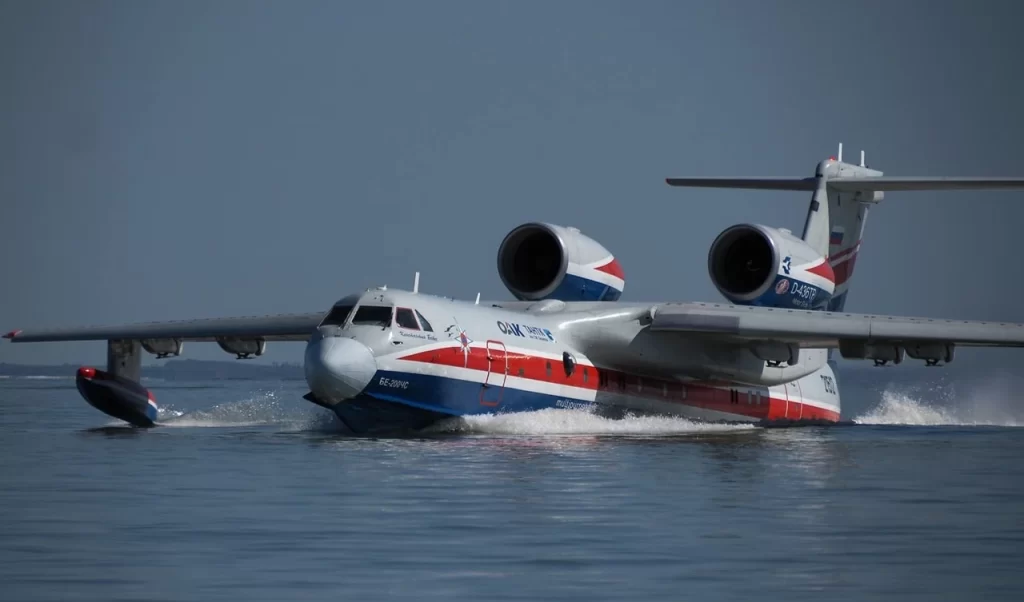The Beriev Be-200 is a unique Russian amphibious jet aircraft that is renowned for its adaptability in the areas of maritime patrol, cargo and passenger transport, search and rescue, and firefighting. It is a critical asset, particularly for Russia’s Ministry of Emergency Situations (EMERCOM), due to its capacity to take off and land on both water and land, as well as its 12-ton water scooping and dropping capacity.
The Be-200 is known for its exceptional firefighting capabilities. It is capable of extracting up to 12 tons of water in a mere 14 to 18 seconds, rendering it highly effective in the suppression of large-scale flames. The aircraft’s operational efficiency during critical firefighting missions is considerably improved by the ability to drop up to 270 tons of water during a single refueling.
The Be-200’s multirole configuration is a noteworthy characteristic. The aircraft is intended to be readily adaptable to various missions. It has the capacity to transport up to 72 passengers, operate as an air ambulance with a capacity of 30 stretchers, transport cargo, or conduct search and rescue operations for up to 45 individuals. The Be-200 is a valuable asset for both civilian and emergency response roles due to its versatility.
The Be-200’s safety and efficacy are further improved by contemporary avionics. The aircraft is outfitted with sophisticated navigation aids, weather radar, and digital flight control systems, which guarantee dependable operation in various conditions. Regardless of the mission profile, the pressurized and air-conditioned cabin ensures the safety and comfort of both the crew and passengers.
Another significant asset of the Be-200 is its operational adaptability. It is capable of landing and taking off from a variety of aquatic bodies, such as lakes, rivers, and coastal areas, as well as unprepared airstrips. The aircraft’s adaptability and effectiveness in various operational environments are emphasized by the availability of specialized variants that are designed to satisfy the unique needs of various missions.

The Engine Transition: From D-436TP to PD-8
Throughout its history, the Be-200 has depended on Ukrainian D-436TP turbofan engines. Nevertheless, Russia has been compelled to expedite its pursuit of technological independence and import substitution as a result of supply chain risks, sanctions, and geopolitical tensions. The domestically developed PD-8 engine by United Engine Corporation (a subsidiary of Rostec) is the solution.
The PD-8 engine is a substantial technical advancement for Russian aviation, particularly for aircraft such as the Be-200. The PD-8 provides a substantial performance improvement over its predecessor, the D-436TP, with a maximal thrust of 8,056 kgf. Its twin-circuit turbofan design is based on the expertise acquired from the development of the larger PD-14 engine and incorporates state-of-the-art Russian materials and 3D printing technologies. It leads to several significant benefits, including a comprehensive support and service infrastructure, enhanced technical autonomy, compliance with contemporary ICAO environmental standards, and reduced operating costs in comparison to foreign alternatives.
A substantial modernization procedure is necessary to incorporate the PD-8 engine into the Be-200. This involves the redesign of the engine nacelles, the modification of the aircraft’s fuel and lubricant systems, and the updating of its control and electronics systems. Special emphasis is being placed on operational durability and corrosion protection in underwater environments due to the Be-200’s amphibious capabilities. The PD-8 is currently undergoing certification on the Sukhoi Superjet SJ-100 regional airliner, with completion anticipated by late 2025. The re-engineering of the Be-200 will commence in effect only after certification. In Russian media, the enhanced variant is occasionally referred to as the Be-200ChS-8 or PD-8-200.
The PD-8 engine’s adoption is expected to have a significant impact from both a strategic and operational standpoint. EMERCOM, the Ministry of Emergency Situations of Russia, presently operates ten Be-200 aircraft and intends to increase the fleet to sixteen units. Ultimately, all of the aircraft will be equipped with PD-8 engines. The transition to a Russian-made engine eliminates previous export barriers, thereby establishing new markets in countries that are susceptible to wildfires, including the United States, Turkey, and Greece. For instance, the utilization of Ukrainian engines resulted in the previous obstruction of a potential US order for ten aircraft. The transition to PD-8 engines is also a fundamental component of Russia’s overarching strategy for technological independence and import substitution in the aviation sector.
The integration of the PD-8 engine into the Be-200 is a complex engineering challenge, despite these advantages. The process necessitates a protracted certification period, rigorous testing, and extensive redesign, which may require several years to complete. In the interim, the current fleet of Be-200s, which are equipped with D-436TP engines, will continue to operate. It is conceivable that a few additional units in the original configuration may be manufactured. Additional testing will primarily focus on the PD-8 engine’s reliability in the high-humidity, corrosive environments typical of amphibious operations. This will ensure that the upgraded Be-200 remains a robust and versatile platform for years to come.
The modernization of the Be-200 is indicative of Russia’s response to external pressures on its aviation industry, with the objective of securing critical capabilities and establishing new export opportunities. The PD-8 engine, which boasts an improved thrust, efficiency, and domestic pedigree, is a critical component of this strategy. It is expected to provide one of the world’s most distinctive amphibious aircraft with improved performance, reliability, and independence.
In conclusion, the Be-200’s transition to Russian PD-8 engines is a significant technological and strategic milestone that guarantees the aircraft’s continued relevance in firefighting, rescue, and export markets. This transition also supports Russia’s pursuit of aviation self-sufficiency and resilience.
Official Website of Youtube Channel – Altitude Addicts